The Woman King exceeds all expectations and is an award contender in all categories.
I was excited about The Woman King from the moment I saw the trailer. Finally, someone had the courage to make a movie about the women who were real life Amazonians, not just myths, and inspired Black Panther‘s Dora Milaje. As someone who is a bit obsessed with female warriors, I’ve been fascinated by stories of the female Agojie warriors of the West African kingdom of Dahomey (now Benin). From the late 1600s until the late 1800s, these fierce women lived to serve, defend, and protect their kingdom and its king. Theirs was a culture which significantly valued women, with all official roles balanced by both a male and female leader. Including the highest rank where the king would bestow the title of Kpojito, or Woman King, upon a female reign mate.
According to producer Cathy Schulman, “This culture had a unique duality. It’s like a fantasy of what would happen if for every job, including a military leader, there could be a woman and a man – a yin and yang of management. And this happened in the real world.”
Dana Stevens and Maria Bello’s script, while a work of fiction, brought the essence of these women to the big screen with smashing success. Director Gina Prince-Bythewood took that script and turned it into a true work of art that reminds you of the power of movies and why we love going to the theaters. Prince-Bythewood said it best when she stated, “In this story, we have the ability to reshape what it means to be female. We’ve never seen this before. I love stories like this that can reframe what it means to be female, reframe femininity, reframe strengths.”
The Woman King: Exactly the movie we need now
There isn’t a weak element in this movie. From the cinematography to the music to the costumes to the editing and of course the stellar performances, this movie is about as perfect as you can get.
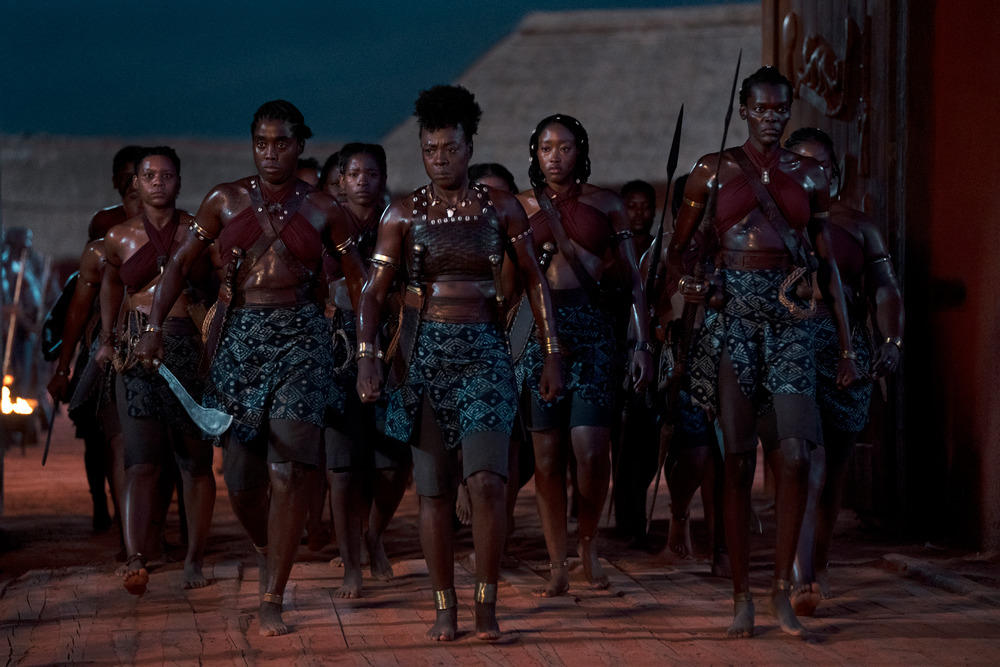
Considering the state of our country right now, this movie is coming out at a pivotal time – a time when female autonomy is under attack, a time when violence against people of color continues with impunity. The importance of having fierce women of color dominating the big screen can’t and shouldn’t be overlooked. According to the latest study by the Annenberg Inclusion Initiative, in 2019, only 28% of women and girls had speaking roles in action and/or adventure films; only 17% of lead roles in all genres went to women; and women over 40 held only 25% of speaking roles compared to men of the same age; black characters made up only 15% of all speaking characters, too. So to have a film staring black women (with a lead who is 56), with a female director (only 10% of directors in 2019 were women), writers (19% were woman), and producers (24% were women), is monumental.
Relationships & politics
The heart of this movie is a story of sisterhood and family. The family that you make, not the one you’re born into. While the training these women go through to become an elite fighting force is intense and not everyone makes it through, these women are forever bonded as sisters in arms. As an Army Iraq War combat veteran I can understand this, and can only hope but wonder what it would have been like to be in a unit of all women – not having to deal with the persistent sexual harassment and abuse.
The Woman King script gives us fully fleshed out characters who we immediately connect to, and the relationships between the women is palpable. Within the larger group of sisterhood, we have the more individual connections that really pull the viewer in and make them see a bit of themselves in these women. From the big sister little sister relationship between Lashana Lynch‘s Izogie and Thuso Mbedu‘s Nadwi, to the ‘best friend who will do anything for you’ relationship between Sheila Atima‘s Amenza and Viola Davis’ Nanisca. The audience is given a glimpse into all the different types of relationships women have with each other, including that of sisters in arms.

While the movie is a female band of warriors, it is set against the political backdrop of the transatlantic slave trade. The Dahomey’s young King Ghezo, played expertly by John Boyega, is immediately challenged by Nanisca to end their involvement in the slave trade. The trade made many of the African kingdoms rich – by selling off their own people – and King Ghezo needs to decide if his kingdom will continue to be involved. As Boyega said in an interview, “The slave trade is going through a transition in that time. I’d call Ghezo as conflicted as anything else, and a young man dealing with the struggles of power on his neck.”
The European side of the trade is represented by Santo Ferreira (Hero Fiennes Tiffin), a Brazilian of Portuguese descent who now masters his own ship, running slaves from Africa. We are also given a glimpse in to the lives of those who don’t really belong anywhere with the character of Malik Diallo (Jordan Bolger), who arrives with Santo. He is the son of a slave (and Dahomey) and a slave trader. He is not quite white and not quite Dahomey. His is on a journey of discovery and growth.
A powerful, authentic cast
Even the best script can fall flat without a strong cast to bring it to life. The Woman King has that in spades. Just like the Agojie warriors were made up of women with varied backgrounds from villages across the region, the cast is made up of women from all over the world of all shades, ages, and body types. Prince-Bythewood said, “I wanted to build an ensemble that represented the incredible diversity of our Diaspora.” Every actor in this film brings a level of power and authenticity to their characters.
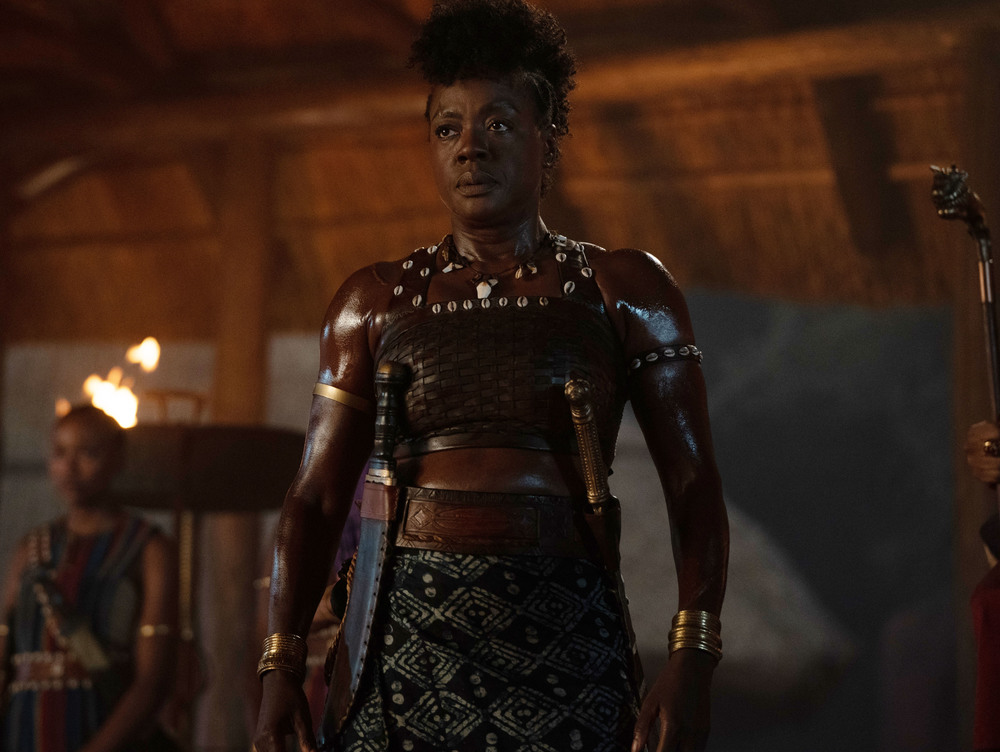
We already knew that Davis was a powerhouse talent. She is the first black performer to achieve the Triple Crown of Acting by winning a competitive Oscar, Emmy, and Tony. She is also the first actress of color to have received four Academy Award nominations. I didn’t think it was possible, but this movie is arguably her most powerful performance ever. The role of Nanisca fits her like a well-worn boxing glove.
In a recent interview Davis said, “I felt The Woman King was an important story because i saw myself in it. I saw my femininity in it. I saw my blackness in it. I saw a really important part of history in it.” Davis dexterously balances the quiet strength of the best politician with the raw ferocity of the most grizzled warrior.

On the opposite side of the spectrum is the young Nawi (Mbedu). The character name is also a tribute to one of the last known Agojie warriors who died in 1979. The audience follows Nawi’s journey from orphan to Agojie warrior. From a stubborn and isolated child who has only known hard work and never known love, to an Agojie warrior who will do anything for her sisters, Mbedu skillfully takes the audience on this complex character journey.
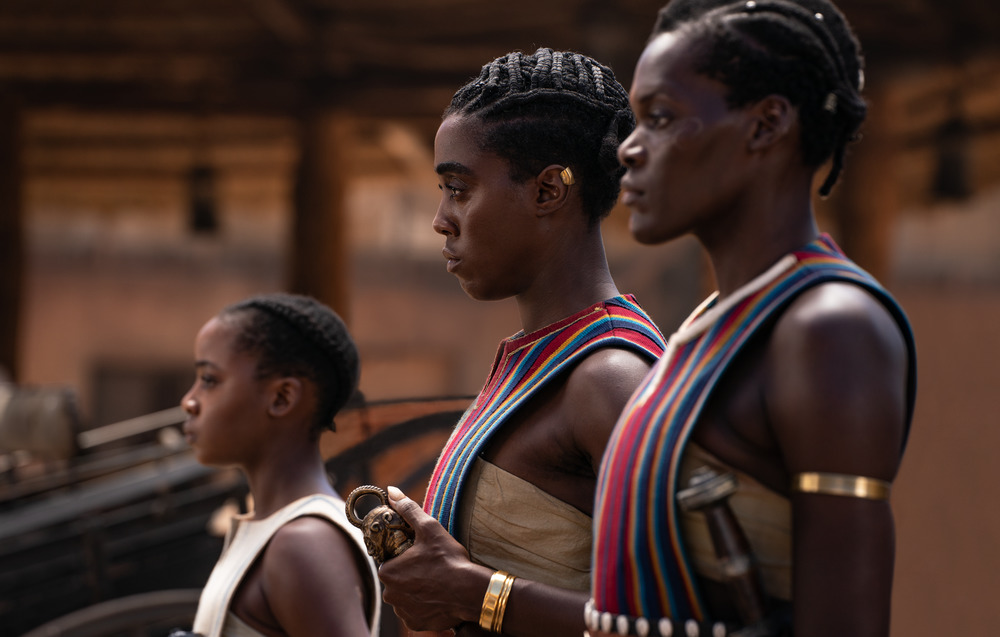
I wish I could say I was surprised at the backlash Lynch faced when she was cast as the new 007 in No Time to Die, but unfortunately women have been dealing with this for decades (just ask Kelly Marie Tran). The abuse was so bad that Lynch deleted her social media accounts. According to The Evening Standard, when asked about the response, Lynch said, “White patriarchy will always have something to say when it comes to things like that. But the magnitude of it was ridiculous.” While her performance as Nomi was fantastic, her role as Izogie in The Woman King should silence any naysayers, and I relish the chance to see her as 007. As one of Nanisca’s lieutenants and the one in charge of training, Izogie is fiercer than any drill sergeant I had an basic training, with her sharpened nails that she uses to rip people’s eyes out with. Her performance has the depth to present us with a character that is a hardened warrior and drill sergeant in one moment and a loving and playful big sister in another.
The story of the Dahomey would be incomplete without a look at the spiritual side of their society. This role is filled by Amenza, played by Atim. She is not only the kingdom’s female religious leader, but the general’s right hand in the Agojie, as well as her oldest friend. Amenza’s calming presence is the perfect balance for Nanisca’s constant rage. The depth of their relationship is one that I think every person wishes they had in their life. Atima plays the character with compassion, strength and one hell of a singing voice.
Exceptional action sequences
But this is obviously a story about warriors, and that story wouldn’t be completed without exceptional fight sequences. The Woman King gives us action sequences that make Wonder Woman’s Amazonians look like amateurs. These are characters that are absolutely built through their physicality. And the women who portrayed the Agojie in this film trained incredibly hard.
According to Prince-Bythewood, the training was “absolutely part of the rehearsal process. It’s how they help build the character. When you train as hard as they did, when you change your body, it changes the way your walk, the way you hold yourself.”
The women trained so hard that they performed the majority of their own stunts. According to stunt and fight coordinator Daniel Hernandez, “I would say that they did 90% of their fight scenes. There are a few specific scenes – like a jump of over 80 feet into water – that required a stunt double. When you seem them fighting, that’s all them.”
Because the film takes place in the 1800s and theirs was a specific way of fighting with machetes and spears, Prince-Bythewood wanted the actors to look like real warriors. In order to do that, lead cast training and nutritionist Gabriela McIain said, “The body’s not going to be as crazy lean, like you see on social media. We tried to keep them more authentic – a real, strong, natural, warrior look.” The result is Agojie warriors of all body types who look like they could break a man in half. And if I dare someone to complain about their arm pit hair (I’m looking at those who criticized Zazie Beetz’s Domino). While Wonder Woman’s Amazonians were aided by the addition of a lot of CGI that gave them a very bright and sleek look, The Woman King‘s Agojie warriors have an element of realness that is often missing from action movies.
Go watch The Woman King now
I could keep going on about all the elements that made this movies so spectacular, but I think the best thing to do is go and see it for yourself. If this film isn’t nominated for every Oscar and BAFTA category it’s eligible for, I will personally storm the Academy of Motion Picture Arts and Sciences building, then fly across the pond to the British Academy of Film and Television Arts building. This is a once in a generation film. It’s a film that deserves a spot on the Best Movies of All Time list and to eventually be added to the National Film Registry. I encourage every woman to find the Agojie warrior inside of them, for our battles are never over.

![The Woman King Reigns Supreme [Review]](https://www.thathashtagshow.com/wp-content/uploads/2022/09/project_20220914_1013222-01-1200x640.png)

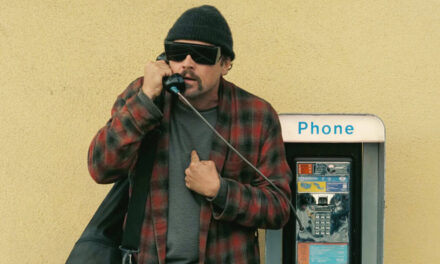
![Animals Return To The Stage In ‘Sing 2’ [Trailer]](https://www.thathashtagshow.com/wp-content/uploads/2021/06/sing-2-440x264.png)